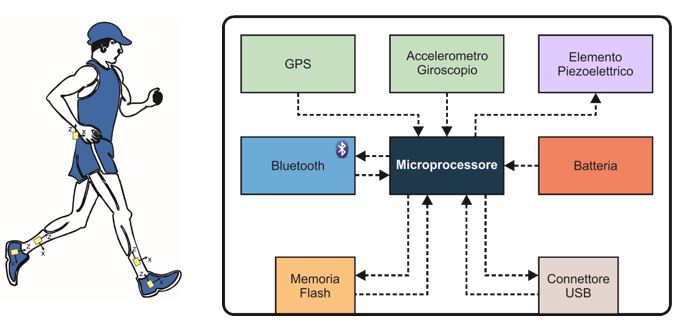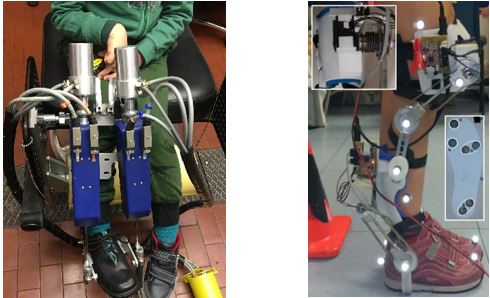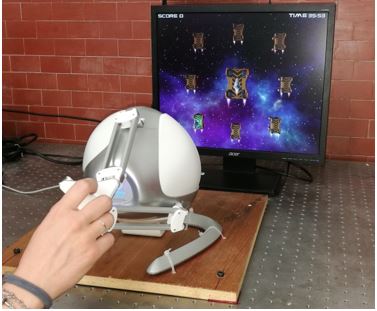| Componenti del gruppo |
|
|
| Stefano Rossi |
ricercatore rtd-B |
DEIM - Università della Tuscia |
| Juri Taborri |
assegnista di ricerca |
DEIM - Università della Tuscia |
| Eduardo Palermo |
ricercatore rtd-A |
DIMA - Università La Sapienza |
| Emilia Scalona |
assegnista di ricerca |
DIMA - Università La Sapienza |
| Francesca Martelli |
PhD student |
|
Le principali attività di ricerca del gruppo sono lo studio delle caratteristiche metrologiche di sensori per la misura del movimento, l’individuazione di parametri oggettivi per la valutazione delle capacità motorie in ambito sportivo e clinico, lo sviluppo ed utilizzo di dispositivi robotici in riabilitazione, lo studio delle caratteristiche metrologiche si strumento termici e meccanici. Si annoverano tra le principali collaborazioni il Dipartimento di Ingegneria Meccanica e Aerospaziale della Sapienza, l’Ospedale Pediatrico Bambino Gesù, l’Istituto Neurologico Carlo Besta.
Tematiche di ricerca
- WARNING (Wearable Apparatus for Recognition Non-Invasive of Normed Gesture): realizzazione di un dispositivo indossabile per la rilevazione automatica delle irregolarità durante la marcia sportiva (patent pending). Il dispositivo tramite algoritmo di machine learning applicato a segnali inerziali fornisce informazioni riguardante lo stato di marcia dell’atleta, ossia se il tipo di marcia è regolare o se è presente una infrazione quale la sospensione, perdita di contatto contemporanea di entrambi i piedi dal terreno, o lo sbloccaggio, completa estensione del ginocchio della gamba in contatto con il terreno.

- PediAnklebot e WAKEup! : progettazione di dispositivi robotici ed implementazione di algoritmi di controllo innovativi per il recupero della mobilità degli arti inferiori (PediAnklebot) e per il recupero funzionale del cammino (WAKEup!).

- Low-Cost Aptic Device (Figura 3): sviluppo di una piattaforma costituita da un dispositivo aptico di basso costo (Novint Falcon) e software open source (Unity) per l’implementazione di protocolli riabilitativi che coinvolgano il più possibile il paziente monitorandone i progressi nel tempo.

Progetti finanziati
- Progetto PRAG-MS “A multicentric randomized PRAGmatic trial to compare the effectiveness of fingolimod versus dimethyl-fumarate on patient overall disease experience in relapsing remitting Multiple Sclerosis: novel data to inform decision-makers”. Il progetto è stato finanziato dall’Istituto di Ricerca “Patient-Centered Outcomes Research Institute”, Washington (USA) ed ha come capofila l’Istituto Neurologico Carlo Besta. Nel presente progetto l’unità operativa del DEIM si occuperà della valutazione della cinematica articolare durante il cammino tramite sistemi di misura inerziali.
- Convenzione con l’Associazione Italiana Pressure Equipment (AIPE). Oggetto della convenzione è la conduzione di uno studio finalizzato alla verifica dell’integrità strutturale di serbatoi verticali V 1000 litri utilizzando la metodologia di verifica basata sul metodo ad Emissione Acustica.
Strumentazione di ricerca in dotazione
- Sensori Inerziali XSENS MTx;
- Elettromiografico wireless a 16 canali - ZeroWire;
- Matrice di pressione – Matscan TEKSCAN;
- Piattaforma di forza a 6 componenti AMTI;
- Celle di carico smorzate e non smorzate di differente fondo scala;
- Schede di acquisizione NATIONAL INSTRUMENTS;
- Unità di condizionamento del segnale estensimetrico;
- Oscilloscopi digitali, multimetri digitali, generatori di segnale.
- Software Labview
Pubblicazioni recenti
- PATANÈ F, ROSSI S, DEL SETTE F, TABORRI J, CAPPA P. “WAKE-up exoskeleton to assist children with Cerebral Palsy: design and preliminary evaluation in level walking.” IEEE Transactions on Neural Systems and Rehabilitation Engineering, 99 (2017).
- GRASSI L, ROSSI S, STUDER V, VASCO G, MOTTA C, PATANÈ F, CASTELLI E, ROSSI Si, CAPPA P. “Quantification of postural stability in minimally disabled multiple sclerosis patients by means of dynamic posturography: an observational study.” Journal of NeuroEngineering and Rehabilitation, 14 (4), (2017).
- ANCILLAO A, ROSSI S, CAPPA P. "Analysis of Knee Strength Measurements Performed by a Hand-Held Multicomponent Dynamometer and Optoelectronic System." IEEE Transactions on Instrumentation and Measurement (66), (2017).
- DI MARCO R, ROSSI S, RACIC V, CAPPA P, MAZZÀ C “Concurrent repeatability and reproducibility analyses of four marker placement protocols for the foot-ankle complex.” Journal of Biomechanics, 49(14), 3168-3176 (2016).
- MOTTA C, PALERMO E, STUDER V, GERMANOTTA M, GERMANI G, CENTONZE D, CAPPA P, ROSSI S, ROSSI St “Disability and fatigue can be objectively measured in Multiple Sclerosis” PloS ONE 11(2) (2016).
- DI MARCO R, ROSSI S, CASTELLI E, PATANÈ F, MAZZÀ C, CAPPA P “Effects of the calibration procedure on the metrological performances of stereophotogrammetric systems for human movement analysis” Measurement (101), (2016).
- TABORRI J, PALERMO E, ROSSI S, CAPPA P “Gait partitioning methods: a systematic review” Sensors 16(1) (2016).
- MILETI I, TABORRI J, ROSSI S, PETRARCA M, PATANÈ F, CAPPA P “Evaluation of the effects on stride-to-stride variability and gait asymmetry in children with Cerebral Palsy wearing the WAKE-up ankle module.” Proceedings of the IEEE International Symposium on Medical Measurements and Applications (MeMeA), Benevento, 15 – 18 May, 2016.
- MARTELLI F, ROSSI S, FRASCARELLI F, GERMANOTTA M, PETRARCA M, CASTELLI E, CAPPA P “Estimation of multivariable dynamic ankle impedance after botulinum toxin injection in children with cerebral palsy.” Proceedings of the IEEE International Symposium on Medical Measurements and Applications (MeMeA), Benevento, 15 – 18 May, 2016.
- TABORRI J, SCALONA E, PALERMO E, ROSSI S, CAPPA P “Validation of inter-subject training for hidden markov models applied to gait phase detection in children with Cerebral Palsy” Sensors 15 (9) (2015): 24514-24529.
- GERMANOTTA M, VASCO G, PETRARCA M, ROSSI S, CARNIEL S, BERTINI E, CAPPA P, CASTELLI E, “Robotic and clinical evaluation of upper limb motor performance in patients with Friedreich’s Ataxia: an observational study” Journal of Neuroengineering and Rehabilitation (2015) 12(1), 41.
- MICHMIZOS K, ROSSI S, CASTELLI E, CAPPA P, KREBS HI, “Robot-Aided Neurorehabilitation: A Pediatric Robot for Ankle Rehabilitation” IEEE Transactions on Neural Systems and Rehabilitation Engineering 99 (2015).
- TABORRI J, ROSSI S, PALERMO E, CAPPA P "A HMM distributed classifier to control robotic knee module of an active orthosis" Proceedings of the IEEE International Conference on Rehabilitation Robotics (ICORR), Singapore 11-14 August, 2015.
- TABORRI J, ROSSI S, PALERMO E, PATANÈ F, CAPPA P “A novel HMM distributed classifier for the detection of gait phases by means of a wearable inertial sensor network” Sensors 14 (9) (2014): 16212-16234.
- PACILLI A, GERMANOTTA M, ROSSI S, CAPPA P “Quantification of age-related differences in reaching and circle-drawing using a robotic rehabilitation device.” Applied Bionics and Biomechanics 11 (2014): 91-104.
- PALERMO E, ROSSI S, PATANÈ F, MARINI F, CAPPA P “Experimental evaluation of accuracy and repeatability of a novel body-to-sensor calibration procedure for inertial sensor-based gait analysis” Measurement 52 (2014): 145-155.
- FORMICA D, PETRARCA M, ROSSI S, ZOLLO L, GUGLIELMELLI E, CAPPA P “Shoulder motor performance assessment in the sagittal plane in children with hemiplegia during single joint pointing tasks” BioMedical Engineering OnLine 13:106 1-17 (2014).
- PALERMO E, ROSSI S, PATANÈ F, CAPPA P “Experimental evaluation of indoor magnetic distortion effects on gait analysis performed with wearable inertial sensors” Physiological Measurement 35 (2014), 3: 399–415.
- ROSSI S, GAZZELLINI S, PETRARCA M, PATANÈ F, SALFA I, CASTELLI E, CAPPA P “Compensation to whole body active rotation perturbation” Gait and Posture, 1 (2014), 39: 621-624.
- ROSSI S, COLAZZA A, PETRARCA M, CASTELLI E, CAPPA P, KREBS HI “Feasibility Study of a Wearable Exoskeleton for Children: Is the Gait Altered by Adding Masses on Lower Limbs?” PLoS ONE, 8 (9) (2013).